
Achieve your creative goals with ease and purpose every day with these tips from successful creatives
Every creative soul knows that creativity, enthusiasm and inspiration too, cannot be consistently sustained or even necessary to do the work. In fact, showing up regardless of a dip in drive or plummet of passion, is what separates the aspiring writers and artists from the successful ones.
Daily habits and creative routines help you connect with your creativity, lure latent inspiration to the surface, and give cues to your mind and brain to slip into work-mode. Your motivation too can be renewed each day because the act and discipline of working in a way optimal to your unique and glorious person, always enhances creativity, and thus your ability to show up and do the work.
“Every writer is different but every professional writer also has some kind of routine to get the words onto the page,” says author entrepreneur, and author of Business for Authors: How to be an Author Entrepreneur, Joanna Penn at The Creative Penn. “You can call this discipline if you like, but it’s better to think of it as a habit. Habits are things you do without having to debate whether to do them or not.”
Choose 3 Big Rocks [So Your Day Rocks Too]
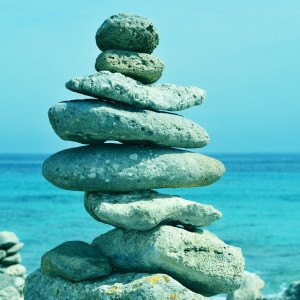
Imagine your day is a glass. Let’s say a pint glass, as I’m a Brit, and each task, goal, and activity, passive or active, a rock of varying size. Let’s say a pebble, as I’m a Brightonian. The great grand rocks are your purpose, your passion, your soul goals—these matter. These are the geological equivalent of your dreams.
The little pebbles are the other ways you spend your time—regardless of how much love of lack thereof you have for—they still matter, just not as much. If you want to fill this glass-like day with these dreamlike rocks, you wouldn’t put the teeny ones in first, or there’d be no room to later add the big important, rocks.
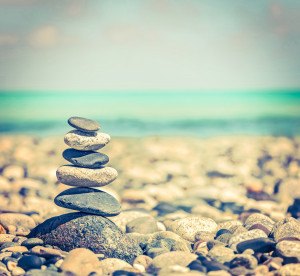
Yet many writers and artists soon find their day has little room left for what’s important: writing and making their art. “The busy person’s perennial question is, “Where did the day go? “It’s easy to get tossed from one thing to the next like a piece of driftwood caught in the tide of your crazy life,” says Lifehacker editor, Gina Trapani.
Although many successful creatives use variations of this practice, Leo Babauta, advocate of all things minimal, efficient and zen, has evolved his equivalent of the three big rocks into MITs or Most Important Tasks. “It’s very simple: your MIT is the task you most want or need to get done today,” says Leo Babauta.
“I have three MITs — the three things I must accomplish today. No matter what else I do today, these are the things I want to be sure of doing.” The key idea is that they sit at the pinnacle of your daily todo list, with you starting your working day with your most important MIT or big rock. Until these rocks are in that glass, all the teeny pebbles are set aside for afterwards.
The Biggest Rock of All—Your Main Goal

“The danger for creative professionals is that incoming demands and digital distractions get in the way of real productivity – i.e. making inroads on your big, scary, difficult, and (ultimately) rewarding creative challenges,” says creative coach, Mark McGuinness of Lateral Action.
“If you do one big thing today – one draft design, one chapter, one photo-shoot, one intensive rehearsal – it feels like a productive day. But if you don’t nail that one thing, it doesn’t matter how many little jobs you get done, you know in your heart it was a wasted day. Asking yourself this question first thing helps you focus and prioritise.”
In ensuring that at least one of your big rocks is related to a main goal, you make progress on what matters most, which always feels good, increasing your momentum to keep going. So your novel, the book you’re writing, exhibition you’re curating, film you’re editing, the website you’re designing—whatever your creative quest is right now—ensure at least one rock moves it forward.
-
What’s the one big thing you want to accomplish today?
-
Ask yourself this each day to focus on & prioritise what matters most to you.
My deepest love is writing fiction so one rock is always related to that—writing my novel, research, or at the least, a free-writing session every day. A far less lovely but equally essential rock is managing a condition so painful, it took the prize for being the world’s most. So this needs to be a rock, a big 3-hour at 5am rock—physical therapy/yoga/meditation/brain-training/chi kung etc.—all before writing or it halts all in an instant but ensuring when able I always work towards what matters the most, it keeps my creative momentum going, and thus purpose and prose.
The Trouble with To-do Lists

The pressure to do more ironically often means we do far less—especially if we put every item on a lengthly to-do list. “All tasks and ideas are added to your lists, which just grows really long. Then you have to decide what to do on your lists, and try and knock off as many tasks as possible. This means that you’re trying to do everything, without real focus on what’s important,” says Leo Babauta.
When working towards what matters, what you do with your time becomes all the more precious as attaining goals, and moving forward in your dreams reveals what a sacred gift it is—acting in tune with your being, on your passions—your purpose. “I try to focus on only those tasks that will really benefit me in the long-term — specifically those that advance my current goal.”
“The secret of getting ahead is getting started. The secret of getting started is breaking your complex overwhelming tasks into small manageable tasks, and then starting on the first one.” — Mark Twain
What’s the Smallest Next Step You Can take?

“Feel free to put all one hundred items you would like to get done on your to-do list, but then take a step back and realise there is a difference between like to get done and absolutely has to get done right now,” says Lauren Sapala.
Instead of overwhelming yourself by the immensity of a project or the sheer amount of things you must do and have left to complete it, simply ask yourself what the next step is, and do that. “Most of us look at something on our list and think, “That’s too hard.” So we put it off because we’re thinking about an entire project, which has many tasks,” says Leo Babauta.
“You can’t do a project right now, you can only do a task. Instead of saying, “I’m going to write that paper that’s due,” you should say, “I’m going to write 3 things in the outline of the paper.” If the smallest task stills seems too hard, say you’re just going to do 5 minutes of that small task right now. Or just two minutes. Make it ridiculously easy.”
The finest solution if feeling momentarily stuck is to free yourself of distraction, and simply take the smallest next step. As Mark Twain said, “The secret of getting ahead is getting started. The secret of getting started is breaking your complex overwhelming tasks into small manageable tasks, and then starting on the first one.”
As you keep showing up and taking the next step, your work evolves, and you do too. “Instead of having a long to-do list of things you want to do today, have just one thing you want to do right now. Instead of saying you’re going to do this important task sometime, say you’re going to do it right now. Instead of allowing yourself to randomly open websites that give you distraction, deliberately figure out what you want to work on next.”
-
What’s the smallest next step you can take?
-
Break down every project into baby steps and tasks.
Dedicate the First Hour of Your Day to Your Most Important Task

One creative practice that many successful writers, artists, and creatives share is that their day begins with their most important work, so that before even the keenest crow has cawed, they’re already working, creating, and doing the work.
“Those hours when you wake up are really precious. And if I lose them, if I waste them, if I get engrossed in the Internet and I drift off down that stream, I really feel guilty and bad afterward,” says author, storyteller, humorist, and radio host, Garrison Keillor.
Though snatching moments to write and create is wonderful, through this simple act your projects evolve more swiftly than with a more erratic process. “Dedicate the first hour of your day to your most important task-before you check your email,” says Gina Trapani.
-
Start your day with an hour of work for your most important project.
-
Whether the ‘logical’ side of that project if that better suits you in the morning, or the ‘creative’ side, if you need to express before the business of the day takes over.
-
Do your most important tasks or big rocks before all else.
-
Keep your motivation powered by the knowledge that you’re doing something to move yourself closer to attaining your creative goals every single day.
Capture Ideas to Stay on Task

“If you’re not regularly emptying the ideas in your head, they will negatively impact your ability to stay focused on present tasks,” says S. J. Scott, author and creator of Develop Good Habits, who suggests creating an ‘idea capture habit’, where you never let an inspiration go unrecorded.
“Even the simple act of writing down a thought and filing it away for future reference helps you stay focused on current projects. That’s why capturing an idea “completes the loops” that often block our ability to get things done. With the idea capture habit, you’ll create a relaxed feeling because every thought will be completed at the appropriate time.” Instead of your mind being filled with a thousand thoughts, you can focus on the task at hand.
Focus on Only One Thing
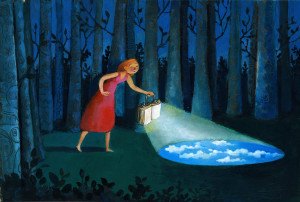
The brain doesn’t like to feel overwhelmed any more than we do. “We’re so distracted, and we’re feeding that instinct every time we move between tasks,” says Tony Schwartz, author of The Way We’re Working Isn’t Working and CEO of the Energy Project. Multitasking as a tool for productivity is a myth, and though myths can be lovely, even Zeus himself only focused one smiting at a time.
“Multitasking can feel like we are getting more done, when we really are not,” says Jackie Johansson, writer and creator of Finally Writing. It’s stressful, wastes energy, exhausting, and ineffective. “Ultimately, the problem is that we spread ourselves thin. The amount of time we have to do our creative work suffers. The work that matters to us, the work that is on our heart, doesn’t get done or doesn’t get the attention it deserves.”
Ensure your focus is as sharp as a single star in the night sky by working exclusively on one task. It not only has measurable effects on your ability to work but also your enjoyment of the creative process too, and anything you love is going to climb a little higher on the ladder of your priorities.”When we do our work with focus and intention we feel full, accomplished and proud,” adds Jackie.
“Do one thing at a time. Writing is a series of in the moment actions strung together. One letter at a time. One word at a time. One sentence at a time. Allow everything else to fall alway. Doing so, you get more done. Your creativity expands. You focus, you ground and spend more time in the flow.”
Workout Your Most Creative Time

“Probably the most essential key to writing success is being realistic about what will—and won’t—work for you,” says writing coach and author, Lauren Sapala. “Take a personal inventory of your best and worst times of day, your strengths and weaknesses, and your primary motivation as a writer. And then take each of these things into account when setting your writing goals and navigating your writing career plan.”
Just as your energy levels fluctuate throughout the day, your own internal rhythms and ability to create also ebbs and flows. Finding the optimum time for you to work on each facet of the creative life and process ensures you’re doing the work you need to at the most beneficial time for you, and your creative offerings.
“I’m a morning person so I need to write fiction in the morning and then do marketing/running the business activities after 2pm. I can also write non-fiction or blog posts/articles in the afternoon, but then I wind down in the evenings,” says Joanna Penn. “Work out when your most creative time is and use it for first draft material.”
Take Your Work into Nature/a Cafe/Library/Bar

“I can’t do the think-work in the studio,” designer and author of Victore or, Who Died and Made You Boss?, James Victore, told 99u. “The studio’s for putting stuff together – for work-work. And if we’re not doing work-work, then we leave. How many great architecture ideas have been drawn on napkins? Because they’re free, they’re not thinking about work.”
No matter the medium of your creative expression, inspiration frequently descends when away from the desk. Equally, part of optimising your creative space is the simple segregation of the two processes, logical and creative, or wild and messy and refined, edited, polished.
“I left the studio every morning and I went to the park and sat for an hour, hour and half. I brought an idea, and I wrote longhand in one of these big sketchbooks. Then I would come into the studio and work. Afterwards, at 4 or 5 o’clock, I’d go to my bar, sit with a beer or two, and refine it. Or write on a new idea. So it became this really nice process of every day. And it became a habit,” says James Victore.
-
Take your creativity outside into the endlessly inspiring natural world.
-
Write in a cafe, library, or if you’re able to, take a long walk, and allow your mind to drift and ideas incubate.
-
When you outside, the pressure drops. You relax, imbued with renewed creativity simply by getting away from your usual place of working, which you keep for the more logical side of your work.
“I need to write new words away from my home desk, because I also use that for podcasting, accounting and other things,” says Joanna Penn. “So I write in libraries or cafes and I always plug in my headphones, listen to rain and thunderstorms album on repeat, turn up the volume and start to write.”
Disconnect to Reconnect—One Day. One Project.

It’s hard to make real progress when you’ve a thousand tasks to complete, as your mind—whether subconsciously or otherwise—is congested, distracted. Diluting your focus and thus ability to work optimally and creatively too. One technique to achieve your creative goals with more ease is to work exclusively on one project per day, and nothing else, while — crucially — disconnecting from the internet.
“To produce great art, the writer needs to be tapped into the flow of the universe,” says author and inspirational writing coach, Lauren Sapala. “In order to tap into this flow, we must approach life with a sense of reverence and awe. If one is feeling a distinct lack of reverence and awe towards life, mindfully restricting internet time could help.”
Lauren suggests having a ‘fiction day’ every week, wherein you do not connect at all, all day, and exclusively focus on your fiction. Of course you can interchange this with whichever creative medium you love or are working on at the moment. The point is to disconnect, to create without the distractions of our online world for the whole day.
“If one is feeling a lack of joy in the act of writing, turning off the social media feed and turning back to the books one loved as a child could help bring that joy back,” says Lauren. Even if your day job is different from your creative work—in vowing only to focus on one project, you’ll find your mind less overwhelmed or congested, your thoughts too, will have more clarity.
It’s a powerful practice—the difference this single act has made to my fiction is huge. Though frequently limited, even on the days when my hands won’t co-operate or the pain‘s too fierce, just the act researching for my novel’s time and setting passively, via audiobooks for instance, is part of this day wherein no contact online is made.
-
Cut yourself off from the grid one day a week.
-
Write vignettes, a short story, or do a free-write. Work on short stories or longer fiction.
-
Take time to be with your work. To know it, discover it, let it take you places by loosening a little of your control while giving yourself the gift of a day to wholly focus and create, no matter the medium of your main goal—your biggest rock—whether it’s a novel, documentary, script, making stars out of glass or writing the world’s finest epic.
Plan & Prioritise—The Night Before
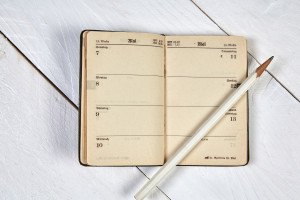
Planning your writing and working day the night before relieves a lot of subconscious weight, and also lets whichever creative project incubate. Despite its simplicity, it can be liberating.
“Decide what you want to write, why you want to write, and what your goal is for the next day. Write it down. Get specific,” says Jackie Johansen. “When you focus your thoughts, distill your ideas and create an intention, you start putting your writing into motion.”
Just as prioritising your day by focusing on your most important tasks helps you attain these goals, planning the night before ensures that you’re ready to work the moment you wake on the first step or task. “When everything you need to write is already assembled, it’s much easier to be spontaneous and devote extra time to your writing,” says Lauren Sapala.
Before your day begins, decide on your big rocks, and also the very first task. “Make sure it’s tiny, achievable and important. Write it down and place it somewhere you will see it, even if it’s a Post-It note on your keyboard. That’s the first thing you’re going to do. No matter what,” says Leo Babauta.
Create Your Own Deadlines

Deadlines increase momentum, and motivation too, for your writing and art. When you make yourself accountable for your goals by giving yourself deadlines, you create the habit of doing, and more crucially, completing your work and thus goals, and once habit, any lingering resistance dissipates, with the entire process becoming far more effortless too.
“Diarize your time and make slots for your writing as you would for any other appointment,” says Joanna Penn. “If you think you don’t have enough time, then look at what to eliminate to make the time. You’ll find a way if you really want to write. It’s all about where you choose to spend your energy. You get what you focus on.”
-
Make appointments with yourself for your writing and creative work.
-
Scan your schedule for windows wherein you can do a little free-writing or a mind-map for a creative project or task.
-
Give yourself deadlines for each step not project. This is because it’s far easier to keep momentum when you see yourself making progress, and it’s far easier to make progress when you break everything into little steps with the benefit of a timeframe in which to complete it.
Find What Works For You [& Simplify]

If you have a routine or system to slip you into the creative process that feels a little stayed, re-organise it, simplify it. Set goals and then break those goals down into small tasks. Then do each task, no matter how tiny but always exclusively. That is moving forward in the most stress-free way possible.
When your mind is relaxed, you are always more productive. It’s far finer for your brain, and thus your ability to create with more joy and ease. Find systems, tools, habits and concepts that work for you personally but always strive to keep it as simple as possible. If you write everything you need do on a single list it will dilute your motivation, and may lead to overwhelm, which isn’t good for you or your creativity.
“The key to productivity, for me, has been simplifying,” says Leo Babauta. “I simplify my to-do list to three things a day, and when I do those things, I really focus on them, eliminating all distractions. I keep my desk clear, my email inbox empty, and my life uncluttered. I eliminate every commitment that doesn’t bring me happiness. The result has been a much simpler, stress-free and happier life.”
The Creative Power of Presence

The simple but powerful act of returning to presence can enhance your process, productivity, and train your brain to focus with more clarity and ease. Noticing when your mind has wandered, and your attention is—and then gently returning to the moment, to the breath—grounds you and keeps you on task.
“Becoming more aware of where your attention is helps you to focus it where you want it to be – on creating something great. Too often we get distracted or get caught in unimportant tasks – coming back to the moment often will help,” says Leo Babauta.
It can be as simple as noticing where your thoughts are, and letting that awareness return you to the breath. “Noticing when your mind has wandered off, letting go of the wandering thought and bringing it back to your breath again,” says Daniel Goleman, psychologist, and author of Emotional Intelligence and Focus.
This has direct, neuroplastic effects on the brain, and trains your attention and focus. “Noticing where your mind has gone gives you the chance for a second thought: “my mind has wandered off again.” That very thought disengages your brain from where it has wandered and activates brain circuits that can help your attention get unstuck and return to the work at hand.”
-
Each time you notice your mind has wandered, soften your face, loosen your belly, and scan your body for tension.
-
Slow the tempo of the breath, inhaling and exhaling gently, evenly, allowing it to find its own natural depth and rhythm.
-
Be aware of how you are holding yourself, keeping your posture straight but body relaxed, as you breath and return to centre.
Stuck? Step Away from Your Desk [& Meditate]

If you find yourself slowing or stuck in your work, the finest solution I’ve found is stepping away from your desk to do a yoga asana or meditation. “There’s usually a time in any project when a stuck moment happens, and I find that getting away from the computer and the busyness of the day is the most important part in successfully battling that,” says creative Sarah Foelske of Bruce Mau Design.
“Even if it’s only for 10 minutes. When you rest your mind, the ideas will come easier. I find any exercise and meditation really helpful, as creativity is all about being focused and present to me.”
Try these natural tools to deliver a dose of inspiration:
-
Meditate for 2 minutes, or simply use the breath to return you to centre wherein your creativity will find the space needed to open and you create with more ease.
-
This acupressure sequence can bring stillness and calm, while refreshing your focus and creativity.
-
If self-criticism is to blame, try these tools to make peace with your inner critic.
-
These acupressure points are ideal if you’re unable to concentrate on your work.
-
Try one of these ancient techniques for a welcome dose of motivation if that’s partially a cause.
-
You may enjoy this 7-Step Process to Align Body, Mind and Soul for Optimum Creativity for healing ways to enhance your creative process.
Make Creating a Daily Habit

Writing and making your art only when you feel inspired to do is a luxury professionals do not subscribe to, for if they did, they wouldn’t be professionals at all. Aside from it leading to far less work, it also creates an erratic process. Unless you have creative habits and tools to get your both butt on chair and words joyfully coaxed, you’re denying yourself one of the finest creative tools of all, routine.
Equally, when making art—no matter the medium—consistency is key. Even if your life leaves little room for your creative expression, the most humble act can create a shift in mindset, and also prime your brain for inspiration, giving you the subconscious cue you need to start working. Carrying a notebook for ideas for example, is the swiftest way to make you see more ideas. It’s as if the act of doing so magnetises you to them, and it’s the same with creative routine.
When you make expressing your creativity a daily habit — and utilise tools for that habit to flow with ease — it loosens the creative terrain a little, freeing the earth and exposing its goodness, the hidden creative gems. Consistently engaging in the act itself is the finest way to create movement, which is all you need if things have become a little too creatively stuck.
Instead of allowing yourself to become rigid, frustrated or unbalanced if work isn’t flowing or as fluid as you wish it to be, make an intention—decide that this is the project you are focusing on and create every day. As Julia Cameron once said, “As you move toward a dream, the dream moves toward you.” But you have to show up, and do the work—daily action is the finest creative habit there is.
FEEL FREE TO SHARE THE LOVE ♥
P.S. Sign-up to my newsletter should the mood take you, Namaste ♥
Follow This Simple Bedtime Routine To Get Writing The Next Day – Finally Writing
Lifehacker: The Guide to Working Smarter, Faster, and Better – Trick Yourself into Getting Done
Garrison Keillor: Start With the Observable World – 99u
10 Questions for Leo Babauta of ZenHabits.net : Getting Things Done
Three Ways to Focus the Wandering Mind – Mindful
James Victore: Don’t Be A Design Zombie
5 Secrets to Hitting Your Writing Goals | Lauren Sapala
14 Bad Productivy Habits (STOP These Before It’s Too Late!)
Geek to Live: Control your workday
Monotasking Your Writing Practice (Prewrite Checklist)

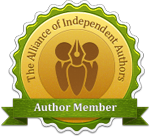


Organisation is very critical to achieving a set goal in life. For me, I like ‘To Do List’. Because it gives me that focus to measure up my progress each day. I thank God today, after reading this article I am even more focused ever than before in achieving my daily goals.
Thanks Brian, I think just as we all need to find our own process, to-do lists work for some but can be overwhelming for others. Though added it in there as I fall into the latter category. Glad you enjoyed, and appreciate your comment. 🙂
“The secret of getting ahead is getting started.” I totally agree with this. This is what has kept me going.
Association is exceptionally basic to accomplishing a set objective in life. For me, I like ‘To Do List’. Since it gives me that center to measure up my advancement every day. I express gratitude toward God today, in the wake of perusing this article I am much more engaged ever than before in accomplishing my every day objectives.
I have finally find a place
I read your post and wished I’d wriettn it